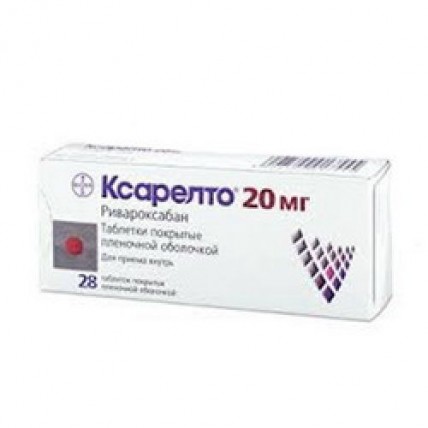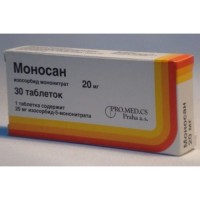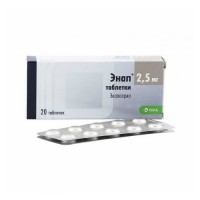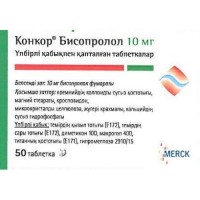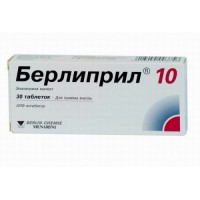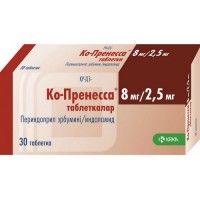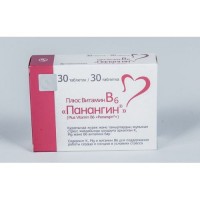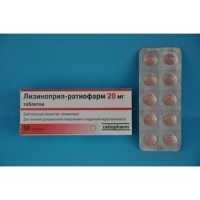Xarelto ® 28's 20 mg film-coated tablets
- $161.00
The instruction for medical use of Xarelto ®â medicine the Trade name of Xarelto ®â the International unlicensed name Rivaroksaban Lekarstvennaya the Tablet form, film coated, 15 mg, 20 mg One tablet contains Structure: active agent - rivaroksaban micronized 15 mg and 20 mg, excipients: microcrystalline cellulose, sodium of a kroskarmelloz, gipromelloz 5 sr (hydroksipropilmetiltsellyuloza of 2910), lactoses monohydrate, magnesium stearate, sodium lauryl sulfate, structure of a cover: ferrous oxide red (E 172), gipromelloza 5 sr (hydroksipropilmetiltsellyuloza of 2910), macrogoal 3350 (polyethyleneglycol (3350)), titan dioxide (E 171). The description of the Tablet, film coated red color (for a dosage of 15 mg), brown-red color (for a dosage of 20 mg) round shape, with biconvex surfaces, with an engraving 15 (for a dosage of 15 mg), with an engraving 20 (for a dosage of 20 mg) and a triangle on one party and a signature bayerovsky cross – on another. Pharmacotherapeutic group the Drugs influencing a hemopoiesis and blood. Anticoagulants. Direct inhibitors Ha factor. Rivaroksaban. The ATX B01AF01 code the Pharmacological Pharmacokinetics Absorption properties and bioavailability Rivaroksaban is quickly soaked up, the maximum concentration (Smaks) are reached in 2-4 hours after reception of a tablet. After intake absorption of a rivaroksaban almost full, absolute bioavailability after reception of tablets of 2.5 mg and 10 mg high also makes 80-100%, irrespective of meal. Meal does not influence PKK (the area under a curve concentration – time) or Smaks (maximum concentration) of a rivaroksaban in doses of 2.5 mg and 10 mg. Owing to decrease in extent of absorption the bioavailability of a rivaroksaban is 66% at reception on an empty stomach of a tablet of 20 mg. At reception of Ксарелто® 20 mg together with food the increase in average PKK for 39% in comparison with PKK is observed at reception on an empty stomach that indicates almost full absorption and high bioavailability at intake. ÈßáÓѽԫ® 15 and 20 mg should be accepted with food (see the section Route of Administration and Doses). The pharmacokinetics of a rivaroksaban has almost linear character at reception of a dose to 15 mg on an empty stomach once a day. After meal the pharmacokinetics of Ксарелто® 10 mg, 15 mg and 20 mg is proportional to a dose. The pharmacokinetics of a rivaroksaban is characterized by moderate variability, the individual variability (variation coefficient) is from 30% to 40%. Absorption of a rivaroksaban depends on the site of its release in digestive tract. It is reported about decrease in PKK and Smaks for 29% and 56%, respectively, at release of granules of a rivaroksaban in proximal department of a small intestine, in comparison with tablets. Exposure decreases even stronger at release of a rivaroksaban in distal department of a small intestine or in the ascending department of a large intestine. Therefore it is necessary to avoid introduction of a rivaroksaban to departments of digestive tract more distally than a stomach as it can lead to decrease in absorption and as a result – to decrease in exposure of a rivaroksaban. The bioavailability (PKK and Smaks) was comparable for the crushed tablet of a rivaroksaban of 20 mg mixed with apple puree and accepted orally or divorced in water and entered via the gastric tube with the subsequent intake of liquid food and for the taken orally integral pill. Considering a pharmacokinetic profile of a rivaroksaban predictable, proportional to a dose, values of bioavailability received in this research, most likely, are applicable to lower doses of a rivaroksaban. Distribution In a human body linking of a rivaroksaban with proteins of plasma, mainly, with the main connecting component – seralbumin, makes about 92-95%. Distribution volume – average, in an equilibrium state (Vss) it is about 50 l. Metabolism and removal About 2/3 of the accepted dose of a rivaroksaban is exposed to metabolic degradation and then is removed with urine and a stake in identical ratios. Remained 1/3 accepted doses it is removed in not changed look by means of direct renal excretion, mainly, due to active renal secretion. Metabolism of a rivaroksaban is carried out by isoenzymes of CYP3A4, CYP2J2 and mechanisms, not dependent on the system of P450 cytochrome. The main sites of biotransformation are the morfolinonovy group which is exposed to oxidizing degradation and the amide bridges which are exposed to hydrolysis. According to the data obtained by in vitro rivaroksaban also Bcrp (squirrel of resistance to a breast cancer) is substrate of proteins carriers R-gp (a glycoprotein P). Not changed rivaroksaban is the most important connection in human plasma, the significant or active circulating metabolites in plasma are absent. Rivaroksaban whose system clearance is about 10 l/h can be carried to medicinal substances with low clearance. After intravenous administration of a rivaroksaban in a dose of 1 mg the elimination half-life makes about 4.5 hours. After oral administration the removal depends on absorption speed. At removal of a rivaroksaban from plasma the terminal elimination half-life makes from 5 to 9 hours at young faces and from 11 to 13 hours at older persons. Separate populations of Paule At men and women of clinically significant distinctions of pharmacokinetics and a pharmacodynamics it is not revealed. Advanced age At elderly patients concentration of a rivaroksaban in plasma is higher, than at young patients, average PKK is about 1.5 times higher, than at young patients, mainly, owing to the reduced general (seeming) and renal clearance. Dose adjustment is not required. Various weight categories Too small or too big weight (& lt, 50 kg or & gt, 120 kg) only slightly affects concentration of a rivaroksaban in plasma (less than for 25%). Dose adjustment is not required. Interethnic distinctions of Clinically significant distinctions of pharmacokinetics and a pharmacodynamics of a rivaroksaban at patients of Caucasian, African American, Latin American, Japanese or Chinese ethnic origin it was not observed. The liver failure At patients with cirrhosis and a slight liver failure (class A on classification of Chayld-Pyyu) pharmacokinetics of a rivaroksaban differs slightly that is expressed by increase in PKK of a rivaroksaban on average by 1.2 times and is comparable to an indicator in control group of healthy faces. For patients with cirrhosis with a moderate liver failure (class B on classification of Chayld-Pyyu) average PKK of a rivaroksaban considerably increased by 2.3 times in comparison with healthy volunteers, free PKK raised by 2.6 times. At these patients the decrease in renal elimination of a rivaroksaban similar to that at patients with a moderate renal failure is also noted. Data at patients with a heavy liver failure are absent. At patients with a moderate liver failure the suppression of activity Ha of a factor was significant stronger (by 2.6 times), than healthy volunteers, had an identical lengthening of a prothrombin time and was 2.1 times. Patients with a moderate liver failure were more sensitive to a rivaroksaban that was expressed in higher pharmacokinetic and pharmakodinamichesky interrelation between concentration of a rivaroksaban and a prothrombin time. Ксарелто® it is contraindicated to patients with the liver diseases which are followed by a coagulopathy and risk of developing clinically significant bleeding including patients with cirrhosis of classes B and C on Chayld-Pyyu (see the section Contraindications). A renal failure At patients with a renal failure the increase in exposure of a rivaroksaban correlating with decrease in renal function according to indicators of clearance of creatinine was observed. At patients with easy (clearance of creatinine of 50-80 ml/min.), moderated (clearance of creatinine of 30-49 ml/min.) and heavy (clearance of creatinine of 15-29 ml/min.) the renal failure observed 1.4-, 1.5- and 1.6-fold increase in concentration of a rivaroksaban in plasma (PKK), respectively. The corresponding increase in pharmakodinamichesky effects was more expressed. At patients with a slight, moderate and heavy renal failure the general suppression of activity Ha of a factor of blood amplified in 1,5, 1,9 and 2 times, respectively, in comparison with healthy volunteers, at the corresponding lengthening of a prothrombin time in 1,3, 2,2 and 2.4 times, respectively. Given at patients with clearance of creatinine & lt, 15 ml/min. are absent. Owing to considerable linking with proteins of plasma of removal of a rivaroksaban by means of dialysis it is not expected. It is not recommended to use drug at patients with clearance of creatinine & lt, 15 ml/min. It is necessary to be careful at use of Xarelto ®® for patients with clearance of creatinine of 15-29 ml/min. (see the section Special Instructions). Pharmacokinetic data at patients At the patients receiving Xarelto ®® in a dose of 20 mg once a day for treatment of an acute deep vein thrombosis, average geometrical concentration (interval of forecasting of 90%) in 2-4 hours and about 24 hours after reception (that approximately reflects the maximum and minimum concentration calculated during the period between receptions) made 215 (22-535) and 32 (6-239) mkg/l, respectively. Pharmacokinetic / pharmakodinamicheskaya interrelation Pharmacokinetic / pharmakodinamicheskaya the interrelation between concentration of a rivaroksaban in blood plasma and several pharmakodinamichesky parameters (inhibition Ha of a factor, the prothrombin time (PT), AChTV, HepTest®) was investigated after administration of drug in the wide range of doses (5 - 30 mg 2 times a day). The interrelation of concentration of a rivaroksaban in blood plasma and activity of Xa of a factor is best described on model of Emaks. Data on PV in general were described better on linear model of pieces. Depending on reagent for definition of PV the biases of curves considerably differed. When using Neoplastin PT reagent initial PV made about 13 seconds, and a curve bias – about 3-4 seconds on 100 mkg/l. Results of the analysis of pharmacokinetics and a pharmacodynamics in clinical trials of II and III phase corresponded to data at healthy volunteers. The children's age Safety and efficiency at children and teenagers is younger than 18 years are not established. A pharmacodynamics the action Mechanism Rivaroksaban – the high-selection direct inhibitor Ha a factor having high bioavailability at oral administration. The inhibition of Xa of a factor interrupts internal and external ways of a cascade of fibrillation that leads both formation of thrombin, and forming of blood clots to suppression. Rivaroksaban does not inhibit thrombin (the activated II factor) and does not influence thrombocytes. Pharmakodinamichesky effects of the Research at the person showed existence of dose-dependent suppression of activity Ha of a factor. Rivaroksaban has dose-dependent impact on a prothrombin time and closely correlates with concentration in plasma (r=0.98) if for the analysis Neoplastin® reagent is used. When using other reagents the results can differ. Instrument reading should be taken in seconds as INR (the international normalized relation) is calibrated and validizirovano only for coumarins and it cannot be applied to other anticoagulants. At the patients accepting Xarelto ®® for treatment of the deep vein thrombosis (DVT) and a pulmonary embolism (TELA) and also prevention of repeated TGV and TELA, 5/95 pertsentily prothrombin times (Неопластин®) in 2-4 hours after reception of a tablet (i.e. during the maximum effect) vary from 17 to 32 seconds for a rivaroksaban in a dose of 15 mg two times a day and from 15 to 30 seconds for a rivaroksaban in a dose of 20 mg once a day, respectively. At the threshold level of 8-16 hours after reception of a tablet, for a rivaroksaban in a dose of 15 mg two times a day 5/95 pertsentily vary from 14 to 24 seconds and in 18-30 hours after reception of a tablet for a rivaroksaban in a dose of 20 mg once a day – from 13 to 20 seconds, respectively. At the patients with not valve fibrillation of auricles (FA) accepting rivaroksaban for prevention of a stroke and a system embolism, 5/95 percentile of a prothrombin time (Неопластин®) in 1-4 hours after reception of a tablet (i.e. during the maximum effect) 20 mg vary from 14 to 40 seconds, tablets of 15 mg at patients with a moderate renal failure once a day once a day – from 10 to 50 seconds. At the minimum concentration (16-36 h after reception of a tablet) 5/95 percentile for a dose of 20 mg from 12 to 26 seconds, for a dose of 15 mg once a day at patients with a moderate renal failure – from 12 to 26 seconds varied once a day. Also Xarelto ®® dozozavisimo increases the activated partial tromboplastinovy time (APTT) and result of HepTest®, however these parameters are not recommended to be used for assessment of pharmakodinamichesky effects of Xarelto ®®. During treatment of Xarelto ®® in carrying out routine monitoring of parameters of fibrillation there is no need. However in the presence of clinical indications the determination of level of a rivaroksaban in blood by means of the calibrated quantitative methods of assessment of inhibition Ha of a factor is possible. Clinical performance and safety Results on efficiency and safety of research III of the phase Einstein Choice Studied Population of 3.396 Patients continued prevention of a recurrence of a venous thrombembolia the Medical dose of Ксарелто® 20 mg of 1 Settl. Account, N=1.107 Ксарелто® 10 of mg of 1 Settl. Account, N=1.127 Acetylsalicylic acid of 100 mg 1 r / days, N=1.131 the treatment Duration
of 349
days of 353
days of 350
days the Simptomny recurrence of VTE 17 (1.5%)* 13 (1.2%) ** 50 (4.4%) the Simptomny recurrence of TELA 6 (0.5%) 6 (0.5%) 19 (1.7%) the Simptomny recurrence of TGV 9 (0.8%) 8 (0.7%) 30 (2.7%) Fatal TELA / death when TELA cannot exclude 2 (0.2%) 0 2 (0.2%) the Simptomny recurrence of VTE, IM, a stroke or a system embolism out of central nervous system 19 (1.7%) 18 (1.6%) 56 (5.0%) Big bleedings 6 (0.5%) 5 (0.4%) 3 (0.3%) Clinically significant small bleeding 30 (2.7) 22 (2.6) 20 (1.8) Simptomny recurrence of VTE or big bleeding (pure clinical advantage) 23 (1.2%) + 17 (1.5%) ++ 53 (4.7%) * p<, 0.001 (superiority) of Ксарелто® 20 mg r / days in comparison with acetylsalicylic acid of 100 mg r / days, the SHOUTING =0.34 (0.20-0.59) ** p<, 0.001 (superiority) of Ксарелто® 10 mg r / days in comparison with acetylsalicylic acid of 100 mg r / days, the SHOUTING =0.26 (0.14-0.47) + Ксарелто® 20 mg r / days in comparison with acetylsalicylic acid of 100 mg r / days, the SHOUTING =0.44 (0.2®7–0.71), p=0.0009 (nominally) ++ Xarelto ® of 10 mg r / days against acetylsalicylic acid of 100 mg r / days, the SHOUTING =0.32 (0.18-0.55), p<, 0.0001 (nominally) Indications - prevention of a stroke and system embolism at adult patients with not valve fibrillation of auricles and one or more risk factors, such as stagnant heart failure, hypertensia, age of ≥75 years, diabetes, earlier postponed strokes or the tranzitorny ischemic attack - treatment of the deep vein thrombosis (DVT) and pulmonary embolism (TELA), and also prevention of repeated TGV and TELA at adults. A route of administration and doses For intake. Ксарелто® it is necessary to accept at meal time. If the patient is not capable to swallow a tablet entirely, it is possible to crush a tablet and to use it, having stirred just before reception with water or food of soft consistence, for example, apple puree then it is necessary to eat food at once. After reception of the crushed tablet Ксарелто® 15 of mg and 20 mg it is necessary to eat food at once. The crushed tablet Xarelto ® can be entered via the gastric tube. Before Xarelto ®'s use it is necessary to confirm the correct position of the gastric tube. The shattered tablet should be entered together with a small amount of water via the gastric tube then it needs to be washed with water, and then to enter an enteroalimentation. Prevention of a stroke and system embolism the Recommended dose makes 20 mg (1 tablet) once a day, daily. Treatment should be continued it is long provided that advantage of prevention of a stroke and system embolism of a preoblad
of t over risk of bleeding. If reception of the next dose is missed, the patient has to accept immediately Xarelto ®® and next day continue regular administration of drug according to the recommended mode. It is not necessary to double the accepted dose for compensation of the dose which is passed earlier. Treatment of the deep vein thrombosis (DVT) and pulmonary embolism (TELA), prevention of repeated TGV and TELA the Recommended dose of Xarelto ®® for initial treatment of sharp TGV or TELA makes 15 mg two times a day within the first 3 weeks, with the subsequent reception of Ксарелто® 20 mg for continuation of therapy and prevention of repeated TGV and TELA once a day. Short-term therapy (at least 3 months) should be considered at patients with TGV and TELA provoked by big tranzitorny risk factors (for example, recent extensive surgeries or an injury). Longer therapy should be considered at patients with provoked by TGV or TELA which are not connected with big tranzitorny risk factors, with unprovoked TGV or TELA or existence in the anamnesis of a recurrence of TGV or TELA. In the presence of indications to long prevention of a recurrence of TGV and TELA (after treatment of TGV or TELA within at least 6 months) the recommended dose makes 10 mg once a day. Patients with high risk of a recurrence of TGV or TELA, such as presence of the complicated associated diseases or a recurrence of TGV or TELA against the background of the prolonged therapy of Xarelto ®® in a preventive dose of 10 mg once a day, it is necessary to consider reception of a dose of Ксарелто® 20 mg once a day. Duration of treatment and a dose have to be selected individually – after careful assessment of advantage of treatment in relation to risk of bleeding. Duration the dosing Mode the General daily dose Treatment and prevention of repeated TGV and TELA C 1 for 21 days of 15 mg two times in day of 30 mg About 22 days and further 20 mg once a day of 20 mg Prevention of repeated TGV and TELA After completion of therapy of TGV and TELA lasting at least 6 months of 10 mg or 20 mg once a day of 10 mg or 20 mg Is recommended to adhere to the mode of regular administration of drug. If reception of the next dose is missed at reception of a dose 15 mg two times a day (1-21 days of treatment), the patient has to accept immediately Xarelto ®® to provide receipt of a daily dose of 30 mg. For this purpose it is possible to take at the same time 2 pill Xarelto ®® in a dose of 15 mg. Next day it is necessary to continue regular administration of drug in a dose of 15 mg 2 times a day compliance with the recommended mode. If administration of drug is missed at reception of a dose 20 mg of 1 times a day, the patient has to accept immediately Xarelto ®® to provide receipt of a daily dose of 20 mg. Next day it is necessary to continue regular administration of drug in a dose of 20 mg according to the recommended mode once a day. It is not necessary to double the accepted dose for compensation of the dose which is passed earlier. Additional information on separate populations of patients Patients with a liver failure of Xarelto ®® it is contraindicated to patients with the liver diseases which are followed by a coagulopathy which causes clinically significant risk of bleedings, including patients with cirrhosis (classes B and C on Chayld-Pyyu) (see the section Contraindications). Patients with a renal failure the Available limited clinical data obtained at patients with a heavy renal failure (clearance of creatinine of 15-29 ml/min.) show substantial increase of concentration of a rivaroksaban at these patients. It is necessary to apply to treatment of this category of patients of Xarelto ®® with care. It is not recommended to use drug at patients with clearance of creatinine & lt, 15 ml/min. For patients with a moderate renal failure (clearance of creatinine of 30-49 ml/min.) or with a heavy renal failure (clearance of creatinine of 15-29 ml/min.) the recommended dose makes: - at prevention of a stroke of a system embolism at patients with not valve fibrillation of auricles the recommended dose makes 15 mg once a day. - for treatment of TGV or TELA, prevention of repeated TGV and TELA the patients have to accept 15 mg two times a day within the first 3 weeks. Then the recommended dose makes 20 mg once a day. The dose decline from 20 mg up to 15 mg should be considered once a day once a day when the estimated risk of bleeding at the patient prevails over risk of repeated TGV and TELA. The recommendation of use of 15 mg is based on pharmacokinetic modeling once a day and not studied in clinical conditions at this state. When assigning Xarelto ®® with a slight renal failure (clearance of creatinine of 50-80 ml/min.) of dose adjustment it is not required to patients. Transition from antagonists of K (ABK) vitamin to Xarelto ®® At patients from not valve FP, for prevention of a stroke and a system embolism reception of AVK it is necessary to stop, and at decrease in the international normalized relation (INR) to ≤3.0 it is necessary to begin treatment of Xarelto ®®. Upon transition of patients from AVK to Xarelto ®®, after reception of Xarelto ®® of MNO value will be in a false manner raised. MNO is not suitable for determination of anticoagulating activity of Xarelto ®® therefore it should not be used for this purpose (see. Medicinal interactions). At patients on treatment of TGV and TELA and on prevention of a recurrence of TGV and TELA the reception of AVK should be stopped, and at decrease in MNO to ≤ 2.5 it is necessary to begin treatment of Xarelto ®®. Upon transition of patients from AVK to Xarelto ®®, after reception of Xarelto ®® of MNO value will be in a false manner raised. MNO is not suitable for determination of anticoagulating activity of Xarelto ®® and therefore it should not be used for this purpose (see. Medicinal interactions). Transition with Xarelto ®® on the antagonists of vitamin K (AVK) Exists the probability of insufficient anticoagulating effect upon transition with Xarelto ®® to AVK. In this regard it is necessary to provide continuous anticoagulating effect during any transition to other anticoagulant. It should be noted that Xarelto ®® can promote increase in MNO. Upon transition with Xarelto ®® to AVK it is necessary to accept at the same time AVK and Xarelto ®® until MNO does not raise up to ≥2.0. During the first two days of a transition period it is necessary to apply a standard initial dose of AVK, then the dose of AVK is selected on MNO. During a concomitant use of Xarelto ®® and ABK, MHO it is necessary to define not earlier than in 24 hours after reception of the previous dose of Xarelto ®®, just before reception of the following dose of Xarelto ®®. Reliable indicators of MNO can be received at least in 24 hours after the termination of reception of Xarelto ®®. Transition from parenteral anticoagulants to Xarelto ®® It is necessary to cancel parenteral anticoagulant and to begin reception of Xarelto ®® in 0-2 hours until the following planned administration of parenteral anticoagulant (for example, low-molecular heparin) or at the time of the termination of continuous administration of parenteral anticoagulant (for example, intravenous administration of unfractionated heparin). Transition with Xarelto ®® to parenteral anticoagulants the First dose of parenteral anticoagulant should be entered into the moment of the following planned reception of Xarelto ®®. Cardioversion at prevention of a stroke and system embolism Treatment of Xarelto ®® can be begun or continued at patients by whom cardioversion can be required. At cardioversion under control of a transesophageal echocardiography (ChPEho-KG) at patients who did not receive anticoagulating therapy earlier for ensuring adequate anti-coagulation treatment of Xarelto ®® it is necessary to begin a minimum in 4 hours prior to cardioversion. For all patients prior to carrying out cardioversion it is necessary to be convinced about the ought Xarelto ®'s use by these patients. In the solution of a question of the beginning and duration of treatment it is necessary to consider the existing guides to anticoagulating therapy at patients with the planned cardioversion. Patients with not valve fibrillation of auricles and the planned ChKV (percutaneous coronary intervention) with stenting there Is a limited experience of a reduced dose of Xarelto ® of 15 mg once a day (or Xarelto ® of 10 mg once a day at patients with a moderate renal failure
) in addition to P2Y12 inhibitor within at most 12 months at patients with not valve fibrillation of auricles with the planned ChKV with stenting which need oral anti-coagulation. The children's age Safety and efficiency at children and teenagers is younger than 18 years is not established. Therefore Xarelto ®® is not recommended for use for children and teenagers 18 years are aged younger. Elderly patients dose adjustment is not required from this category of patients. A floor, body weight or ethnic origin is not required to dose adjustment on the basis of these criteria. Side effects the List of side reactions Summary data on the frequency of the side reactions registered when using Xarelto ®® are given below on classes of systems of bodies (MedDRA) and frequency. Side reactions are determined by frequency as: very frequent (≥ 1/10) frequent (from ≥1/100 to & lt, 1/10) infrequent (from ≥ 1/1000 to & lt, 1/100) rare (from ≥ 1/10000 to & lt, 1/1000) very rare (& lt, 1/10000) with an unknown frequency (frequency cannot be established on the available data) Often (from ≥1/100 to & lt, 1/10) - anemia (including the corresponding laboratory parameters) - dizziness, a headache - a hematopsia (including hemorrhage in a conjunctiva) - arterial hypotension, a hematoma - nasal bleeding, a pneumorrhagia - gingival bleeding, gastrointestinal bleeding (including rectal bleeding), pains in digestive tract and a stomach, dyspepsia, nausea, a constipation *, diarrhea, vomiting * - an itching (including infrequent cases of a generalized itching), rash, ecchymomas, skin and hypodermic hemorrhages - extremity pains * - bleeding from an urogenital path (including a hamaturia and a menorrhagia **), a renal failure (including increase in level of creatinine in blood, increase in level of urea in blood) * - fever *, peripheral hypostases, deterioration in overall health (including fatigue and an asthenia) - increase in level of transaminases - hemorrhages after the carried-out procedures (including postoperative anemia and bleeding from a wound), bruise, discharges from a wound * Infrequently (from ≥1/1000 to & lt, 1/100) - a thrombocytosis (including the raised number of thrombocytes) * - thrombocytopenia (were observed also during post-marketing experience in vremennóy interrelations with use of Xarelto ®®) - allergic reaction, allergic dermatitis - intracerebral and intracraneal hemorrhages, a faint - tachycardia - dryness in a mouth - an abnormal liver function - urticaria - a hemarthrosis - feeling sick, including an indisposition - increase in levels of bilirubin, alkaline phosphatase *, lactate dehydrogenases (LDG) *, lipases *, amylases *, gamma glyutamiltransferazy (GGT *) in blood - a Quincke's disease and allergic hypostasis (were observed also during post-marketing experience in vremennóy interrelations with use of Xarelto ®®). Seldom (from ≥1/10000 to & lt, 1/1000) - jaundice - a cholestasia, hepatitis, including hepatocellular damage (were observed also during post-marketing experience in vremennóy interrelations with use of Xarelto ®®). - hemorrhage in muscles - local hypostasis * - increase in level of the conjugated bilirubin (at the accompanying increase in an alanintrasferaza or without it) - a vascular pseudoaneurysm (it was observed as infrequent at prevention of aterotrombotichesky events at patients after a sharp coronary syndrome (after chrezkozhny intervention on coronary vessels)) Very seldom (& lt, 1/10000) - Stephens Johnson's syndrome / a toxic epidermal necrolysis (were observed during post-marketing observation in temporary interrelation with use of Xarelto ®®). With an unknown frequency: - a compartment syndrome owing to bleeding - a renal failure / an acute renal failure owing to the bleeding sufficient for development of hypoperfusion * were observed at adult patients when performing prevention of VTE after endoprosthesis replacement of knee or coxofemoral joints ** were observed as very frequent at treatment of TGV, TELA and prevention of their recurrence at women at age & lt, 55 years the Description of some side reactions Considering the pharmacological mechanism of action Xarelto ®®, its use can be followed by the increased risk of the concealed or obvious hemorrhage from any bodies and fabrics which can lead to posthemorrhagic anemia. Signs, symptoms and weight (including a lethal outcome) vary depending on localization and severity or massiveness of bleeding and/or anemia (see the section (Treatment of bleedings). In clinical trials of bleeding from mucous membranes (for example, nasal, gingival, gastrointestinal, from an urinogenital path including the pathological vaginal and strengthened menstrual bleeding) and anemia were often noted at long-term treatment of Xarelto ®® in comparison with treatment by antagonists of K (ABK) vitamin. Therefore, in addition to adequate clinical examination, if necessary, for detection of the concealed hemorrhage the laboratory determination of level of a hemoglobin/hematocrit and quantitative assessment of the clinical importance of obvious bleeding can matter. Risk of developing bleeding can be increased at some groups of patients, for example, with uncontrollable heavy arterial hypertension and/or receiving the accompanying treatment by the drugs influencing a hemostasis (see the section Special Instructions). Menstrual bleedings can be longer and intensive. Hemorrhagic complications can be shown by weakness, pallor, dizziness, a headache, an inexplicable swelling, an asthma or an inexplicable state of shock. In certain cases, owing to anemia myocardium ischemia symptoms such as stethalgias or stenocardia were observed. At use of Xarelto ®® owing to heavy bleeding also such known complications as a compartment syndrome and a renal failure as a result of hypoperfusion were registered. Therefore at assessment of a condition of any patient receiving anticoagulants it is necessary to consider the possibility of hemorrhage. The message about suspects is undesirable
to be Developed
of 349
days of 353
days of 350
days the Simptomny recurrence of VTE 17 (1.5%)* 13 (1.2%) ** 50 (4.4%) the Simptomny recurrence of TELA 6 (0.5%) 6 (0.5%) 19 (1.7%) the Simptomny recurrence of TGV 9 (0.8%) 8 (0.7%) 30 (2.7%) Fatal TELA / death when TELA cannot exclude 2 (0.2%) 0 2 (0.2%) the Simptomny recurrence of VTE, IM, a stroke or a system embolism out of central nervous system 19 (1.7%) 18 (1.6%) 56 (5.0%) Big bleedings 6 (0.5%) 5 (0.4%) 3 (0.3%) Clinically significant small bleeding 30 (2.7) 22 (2.6) 20 (1.8) Simptomny recurrence of VTE or big bleeding (pure clinical advantage) 23 (1.2%) + 17 (1.5%) ++ 53 (4.7%) * p<, 0.001 (superiority) of Ксарелто® 20 mg r / days in comparison with acetylsalicylic acid of 100 mg r / days, the SHOUTING =0.34 (0.20-0.59) ** p<, 0.001 (superiority) of Ксарелто® 10 mg r / days in comparison with acetylsalicylic acid of 100 mg r / days, the SHOUTING =0.26 (0.14-0.47) + Ксарелто® 20 mg r / days in comparison with acetylsalicylic acid of 100 mg r / days, the SHOUTING =0.44 (0.2®7–0.71), p=0.0009 (nominally) ++ Xarelto ® of 10 mg r / days against acetylsalicylic acid of 100 mg r / days, the SHOUTING =0.32 (0.18-0.55), p<, 0.0001 (nominally) Indications - prevention of a stroke and system embolism at adult patients with not valve fibrillation of auricles and one or more risk factors, such as stagnant heart failure, hypertensia, age of ≥75 years, diabetes, earlier postponed strokes or the tranzitorny ischemic attack - treatment of the deep vein thrombosis (DVT) and pulmonary embolism (TELA), and also prevention of repeated TGV and TELA at adults. A route of administration and doses For intake. Ксарелто® it is necessary to accept at meal time. If the patient is not capable to swallow a tablet entirely, it is possible to crush a tablet and to use it, having stirred just before reception with water or food of soft consistence, for example, apple puree then it is necessary to eat food at once. After reception of the crushed tablet Ксарелто® 15 of mg and 20 mg it is necessary to eat food at once. The crushed tablet Xarelto ® can be entered via the gastric tube. Before Xarelto ®'s use it is necessary to confirm the correct position of the gastric tube. The shattered tablet should be entered together with a small amount of water via the gastric tube then it needs to be washed with water, and then to enter an enteroalimentation. Prevention of a stroke and system embolism the Recommended dose makes 20 mg (1 tablet) once a day, daily. Treatment should be continued it is long provided that advantage of prevention of a stroke and system embolism of a preoblad
of t over risk of bleeding. If reception of the next dose is missed, the patient has to accept immediately Xarelto ®® and next day continue regular administration of drug according to the recommended mode. It is not necessary to double the accepted dose for compensation of the dose which is passed earlier. Treatment of the deep vein thrombosis (DVT) and pulmonary embolism (TELA), prevention of repeated TGV and TELA the Recommended dose of Xarelto ®® for initial treatment of sharp TGV or TELA makes 15 mg two times a day within the first 3 weeks, with the subsequent reception of Ксарелто® 20 mg for continuation of therapy and prevention of repeated TGV and TELA once a day. Short-term therapy (at least 3 months) should be considered at patients with TGV and TELA provoked by big tranzitorny risk factors (for example, recent extensive surgeries or an injury). Longer therapy should be considered at patients with provoked by TGV or TELA which are not connected with big tranzitorny risk factors, with unprovoked TGV or TELA or existence in the anamnesis of a recurrence of TGV or TELA. In the presence of indications to long prevention of a recurrence of TGV and TELA (after treatment of TGV or TELA within at least 6 months) the recommended dose makes 10 mg once a day. Patients with high risk of a recurrence of TGV or TELA, such as presence of the complicated associated diseases or a recurrence of TGV or TELA against the background of the prolonged therapy of Xarelto ®® in a preventive dose of 10 mg once a day, it is necessary to consider reception of a dose of Ксарелто® 20 mg once a day. Duration of treatment and a dose have to be selected individually – after careful assessment of advantage of treatment in relation to risk of bleeding. Duration the dosing Mode the General daily dose Treatment and prevention of repeated TGV and TELA C 1 for 21 days of 15 mg two times in day of 30 mg About 22 days and further 20 mg once a day of 20 mg Prevention of repeated TGV and TELA After completion of therapy of TGV and TELA lasting at least 6 months of 10 mg or 20 mg once a day of 10 mg or 20 mg Is recommended to adhere to the mode of regular administration of drug. If reception of the next dose is missed at reception of a dose 15 mg two times a day (1-21 days of treatment), the patient has to accept immediately Xarelto ®® to provide receipt of a daily dose of 30 mg. For this purpose it is possible to take at the same time 2 pill Xarelto ®® in a dose of 15 mg. Next day it is necessary to continue regular administration of drug in a dose of 15 mg 2 times a day compliance with the recommended mode. If administration of drug is missed at reception of a dose 20 mg of 1 times a day, the patient has to accept immediately Xarelto ®® to provide receipt of a daily dose of 20 mg. Next day it is necessary to continue regular administration of drug in a dose of 20 mg according to the recommended mode once a day. It is not necessary to double the accepted dose for compensation of the dose which is passed earlier. Additional information on separate populations of patients Patients with a liver failure of Xarelto ®® it is contraindicated to patients with the liver diseases which are followed by a coagulopathy which causes clinically significant risk of bleedings, including patients with cirrhosis (classes B and C on Chayld-Pyyu) (see the section Contraindications). Patients with a renal failure the Available limited clinical data obtained at patients with a heavy renal failure (clearance of creatinine of 15-29 ml/min.) show substantial increase of concentration of a rivaroksaban at these patients. It is necessary to apply to treatment of this category of patients of Xarelto ®® with care. It is not recommended to use drug at patients with clearance of creatinine & lt, 15 ml/min. For patients with a moderate renal failure (clearance of creatinine of 30-49 ml/min.) or with a heavy renal failure (clearance of creatinine of 15-29 ml/min.) the recommended dose makes: - at prevention of a stroke of a system embolism at patients with not valve fibrillation of auricles the recommended dose makes 15 mg once a day. - for treatment of TGV or TELA, prevention of repeated TGV and TELA the patients have to accept 15 mg two times a day within the first 3 weeks. Then the recommended dose makes 20 mg once a day. The dose decline from 20 mg up to 15 mg should be considered once a day once a day when the estimated risk of bleeding at the patient prevails over risk of repeated TGV and TELA. The recommendation of use of 15 mg is based on pharmacokinetic modeling once a day and not studied in clinical conditions at this state. When assigning Xarelto ®® with a slight renal failure (clearance of creatinine of 50-80 ml/min.) of dose adjustment it is not required to patients. Transition from antagonists of K (ABK) vitamin to Xarelto ®® At patients from not valve FP, for prevention of a stroke and a system embolism reception of AVK it is necessary to stop, and at decrease in the international normalized relation (INR) to ≤3.0 it is necessary to begin treatment of Xarelto ®®. Upon transition of patients from AVK to Xarelto ®®, after reception of Xarelto ®® of MNO value will be in a false manner raised. MNO is not suitable for determination of anticoagulating activity of Xarelto ®® therefore it should not be used for this purpose (see. Medicinal interactions). At patients on treatment of TGV and TELA and on prevention of a recurrence of TGV and TELA the reception of AVK should be stopped, and at decrease in MNO to ≤ 2.5 it is necessary to begin treatment of Xarelto ®®. Upon transition of patients from AVK to Xarelto ®®, after reception of Xarelto ®® of MNO value will be in a false manner raised. MNO is not suitable for determination of anticoagulating activity of Xarelto ®® and therefore it should not be used for this purpose (see. Medicinal interactions). Transition with Xarelto ®® on the antagonists of vitamin K (AVK) Exists the probability of insufficient anticoagulating effect upon transition with Xarelto ®® to AVK. In this regard it is necessary to provide continuous anticoagulating effect during any transition to other anticoagulant. It should be noted that Xarelto ®® can promote increase in MNO. Upon transition with Xarelto ®® to AVK it is necessary to accept at the same time AVK and Xarelto ®® until MNO does not raise up to ≥2.0. During the first two days of a transition period it is necessary to apply a standard initial dose of AVK, then the dose of AVK is selected on MNO. During a concomitant use of Xarelto ®® and ABK, MHO it is necessary to define not earlier than in 24 hours after reception of the previous dose of Xarelto ®®, just before reception of the following dose of Xarelto ®®. Reliable indicators of MNO can be received at least in 24 hours after the termination of reception of Xarelto ®®. Transition from parenteral anticoagulants to Xarelto ®® It is necessary to cancel parenteral anticoagulant and to begin reception of Xarelto ®® in 0-2 hours until the following planned administration of parenteral anticoagulant (for example, low-molecular heparin) or at the time of the termination of continuous administration of parenteral anticoagulant (for example, intravenous administration of unfractionated heparin). Transition with Xarelto ®® to parenteral anticoagulants the First dose of parenteral anticoagulant should be entered into the moment of the following planned reception of Xarelto ®®. Cardioversion at prevention of a stroke and system embolism Treatment of Xarelto ®® can be begun or continued at patients by whom cardioversion can be required. At cardioversion under control of a transesophageal echocardiography (ChPEho-KG) at patients who did not receive anticoagulating therapy earlier for ensuring adequate anti-coagulation treatment of Xarelto ®® it is necessary to begin a minimum in 4 hours prior to cardioversion. For all patients prior to carrying out cardioversion it is necessary to be convinced about the ought Xarelto ®'s use by these patients. In the solution of a question of the beginning and duration of treatment it is necessary to consider the existing guides to anticoagulating therapy at patients with the planned cardioversion. Patients with not valve fibrillation of auricles and the planned ChKV (percutaneous coronary intervention) with stenting there Is a limited experience of a reduced dose of Xarelto ® of 15 mg once a day (or Xarelto ® of 10 mg once a day at patients with a moderate renal failure
) in addition to P2Y12 inhibitor within at most 12 months at patients with not valve fibrillation of auricles with the planned ChKV with stenting which need oral anti-coagulation. The children's age Safety and efficiency at children and teenagers is younger than 18 years is not established. Therefore Xarelto ®® is not recommended for use for children and teenagers 18 years are aged younger. Elderly patients dose adjustment is not required from this category of patients. A floor, body weight or ethnic origin is not required to dose adjustment on the basis of these criteria. Side effects the List of side reactions Summary data on the frequency of the side reactions registered when using Xarelto ®® are given below on classes of systems of bodies (MedDRA) and frequency. Side reactions are determined by frequency as: very frequent (≥ 1/10) frequent (from ≥1/100 to & lt, 1/10) infrequent (from ≥ 1/1000 to & lt, 1/100) rare (from ≥ 1/10000 to & lt, 1/1000) very rare (& lt, 1/10000) with an unknown frequency (frequency cannot be established on the available data) Often (from ≥1/100 to & lt, 1/10) - anemia (including the corresponding laboratory parameters) - dizziness, a headache - a hematopsia (including hemorrhage in a conjunctiva) - arterial hypotension, a hematoma - nasal bleeding, a pneumorrhagia - gingival bleeding, gastrointestinal bleeding (including rectal bleeding), pains in digestive tract and a stomach, dyspepsia, nausea, a constipation *, diarrhea, vomiting * - an itching (including infrequent cases of a generalized itching), rash, ecchymomas, skin and hypodermic hemorrhages - extremity pains * - bleeding from an urogenital path (including a hamaturia and a menorrhagia **), a renal failure (including increase in level of creatinine in blood, increase in level of urea in blood) * - fever *, peripheral hypostases, deterioration in overall health (including fatigue and an asthenia) - increase in level of transaminases - hemorrhages after the carried-out procedures (including postoperative anemia and bleeding from a wound), bruise, discharges from a wound * Infrequently (from ≥1/1000 to & lt, 1/100) - a thrombocytosis (including the raised number of thrombocytes) * - thrombocytopenia (were observed also during post-marketing experience in vremennóy interrelations with use of Xarelto ®®) - allergic reaction, allergic dermatitis - intracerebral and intracraneal hemorrhages, a faint - tachycardia - dryness in a mouth - an abnormal liver function - urticaria - a hemarthrosis - feeling sick, including an indisposition - increase in levels of bilirubin, alkaline phosphatase *, lactate dehydrogenases (LDG) *, lipases *, amylases *, gamma glyutamiltransferazy (GGT *) in blood - a Quincke's disease and allergic hypostasis (were observed also during post-marketing experience in vremennóy interrelations with use of Xarelto ®®). Seldom (from ≥1/10000 to & lt, 1/1000) - jaundice - a cholestasia, hepatitis, including hepatocellular damage (were observed also during post-marketing experience in vremennóy interrelations with use of Xarelto ®®). - hemorrhage in muscles - local hypostasis * - increase in level of the conjugated bilirubin (at the accompanying increase in an alanintrasferaza or without it) - a vascular pseudoaneurysm (it was observed as infrequent at prevention of aterotrombotichesky events at patients after a sharp coronary syndrome (after chrezkozhny intervention on coronary vessels)) Very seldom (& lt, 1/10000) - Stephens Johnson's syndrome / a toxic epidermal necrolysis (were observed during post-marketing observation in temporary interrelation with use of Xarelto ®®). With an unknown frequency: - a compartment syndrome owing to bleeding - a renal failure / an acute renal failure owing to the bleeding sufficient for development of hypoperfusion * were observed at adult patients when performing prevention of VTE after endoprosthesis replacement of knee or coxofemoral joints ** were observed as very frequent at treatment of TGV, TELA and prevention of their recurrence at women at age & lt, 55 years the Description of some side reactions Considering the pharmacological mechanism of action Xarelto ®®, its use can be followed by the increased risk of the concealed or obvious hemorrhage from any bodies and fabrics which can lead to posthemorrhagic anemia. Signs, symptoms and weight (including a lethal outcome) vary depending on localization and severity or massiveness of bleeding and/or anemia (see the section (Treatment of bleedings). In clinical trials of bleeding from mucous membranes (for example, nasal, gingival, gastrointestinal, from an urinogenital path including the pathological vaginal and strengthened menstrual bleeding) and anemia were often noted at long-term treatment of Xarelto ®® in comparison with treatment by antagonists of K (ABK) vitamin. Therefore, in addition to adequate clinical examination, if necessary, for detection of the concealed hemorrhage the laboratory determination of level of a hemoglobin/hematocrit and quantitative assessment of the clinical importance of obvious bleeding can matter. Risk of developing bleeding can be increased at some groups of patients, for example, with uncontrollable heavy arterial hypertension and/or receiving the accompanying treatment by the drugs influencing a hemostasis (see the section Special Instructions). Menstrual bleedings can be longer and intensive. Hemorrhagic complications can be shown by weakness, pallor, dizziness, a headache, an inexplicable swelling, an asthma or an inexplicable state of shock. In certain cases, owing to anemia myocardium ischemia symptoms such as stethalgias or stenocardia were observed. At use of Xarelto ®® owing to heavy bleeding also such known complications as a compartment syndrome and a renal failure as a result of hypoperfusion were registered. Therefore at assessment of a condition of any patient receiving anticoagulants it is necessary to consider the possibility of hemorrhage. The message about suspects is undesirable
to be Developed
